From HCM to HMC: HRBP Role Becomes the Most Challenging Strategic Nexus in the Human–Machine Era
- Judy

- 2 days ago
- 6 min read
Updated: 7 hours ago
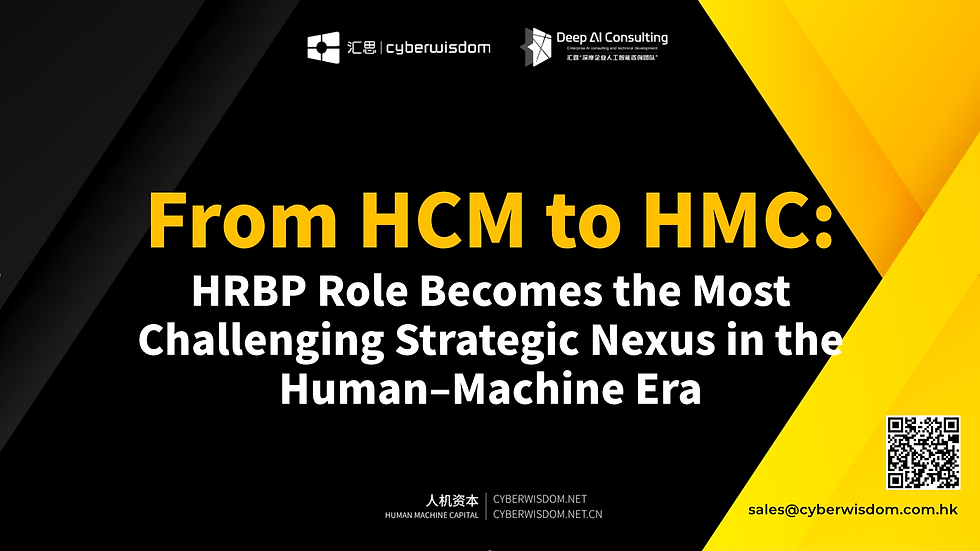
As enterprises transition from Human Capital Management (HCM) to Human Machine Capital (HMC), the Human Resources Business Partner (HRBP) becomes the most strategically strained and structurally pivotal role. Traditional deployments of AI that merely automate administrative transactions (e.g., payroll validation, résumé parsing, attendance reconciliation) represent only the first efficiency layer. The decisive competitive advantage now resides in architecting sustained Human–Machine Collaboration (HMC): designing workflows where cognitive AI agents, digital employees (bots), and human talent form an adaptive value network. This article explains why the HRBP must evolve into an HMC Orchestrator, identifies the capability gaps, proposes an operating and governance architecture, defines measurable value, and lays out a pragmatic transformation roadmap.
1. The Structural Shift: From Managing People to Managing Human–Machine Value Networks
HCM treats the individual employee as the primary production node; optimization logic centers on attraction, development, engagement and retention. HMC reframes the production system as a composite lattice of:
Human-centric strengths: contextual judgment, ethical framing, socio-emotional influence, creative abstraction, narrative synthesis.
Machine-centric strengths: scale computation, pattern mining, hyper-consistency, semantic recall, real-time simulation.
Collaborative emergent strengths: accelerated problem cycles, reduction of cognitive switching costs, institutionalized learning loops, adaptive decision fusion.
In HMC, HR no longer manages “roles” alone; it curates interaction protocols between human contributors, AI agents, autonomous workflows, and evolving knowledge graphs. The locus of optimization shifts from individual role productivity to interfacial throughput: the latency, fidelity, resilience, and ethical integrity of human–machine task handoffs.
2. Why the HRBP Role Becomes Uniquely Challenging
2.1 Multidimensional Stewardship
The HRBP straddles four expanding accountability planes simultaneously:
Business Value Translation: converting strategic goals (e.g., customer lifetime value uplift) into blended human–machine capability portfolios.
Talent Architecture: reconceiving roles as modular capability bundles with machine-augmentable surfaces.
Collaboration Design: specifying when orchestration is push (AI proactively suggests) versus pull (human solicits augmentation) and how escalation thresholds are governed.
Trust & Risk Mediation: ensuring ethical transparency, bias mitigation, explainability, and psychological safety during augmentation adoption.
2.2 Decision Density and Temporal Compression
Cycle times for capability shifts shrink (quarterly → bi-weekly). HRBPs must interpret real-time collaboration telemetry (agent utilization spikes, exception reroutes, knowledge reuse decay) and recalibrate skill investments without destabilizing human motivation.
2.3 Invisible Failure Modes
Misalignment in HMC often manifests indirectly: quiet degradation of tacit knowledge, tool over-reliance eroding human judgment, or silent algorithmic drift producing sociotechnical bias. HRBP must develop “sensing frameworks” to detect these second-order risks earlier than traditional employee pulse surveys can.
2.4 Ethical Ambiguity Zones
Ambiguous terrain emerges around:
Attribution: who “owns” composite output when an agent drafts 70% of a proposal?
Performance Fairness: how to apportion incentives when productivity delta is partially machine-amplified?
Surveillance Boundaries: differentiation between augmentation telemetry versus intrusive monitoring.
The HRBP becomes the adjudicator of moral thresholds operationalized into policy grammar.
3. Beyond Administrative AI: The Maturity Ladder
Organizations plateau when AI remains an administrative prosthetic. A four-level HMC maturity model illustrates escalation of strategic depth:
Reactive Automation: Discrete HR workflows (onboarding docs, leave validation) automated; minimal interaction design.
Augmented Execution: Point AI tools assist humans (interview summarization, skills inference); silos persist.
Orchestrated Collaboration: Inter-agent + human workflows choreographed; shared ontologies; feedback loops instrumented.
Symbiotic Value Networks: Dynamic task allocation engines; predictive reskilling paths; emergent knowledge graphs powering self-improving collaboration patterns.
The HRBP is critical in catalyzing the leap from 2 → 3 → 4 through governance formalization, capability reframing, and adoption psychology management.
4. The HMC HRBP Competency Model
Eight advanced competencies reconstitute the role:
Tech Fluency (Applied): Interpret model capabilities/limitations, latency-impact tradeoffs, data lineage.
Human–Machine Workflow Design: Map tasks to capability vectors; optimize handoff granularity; reduce cognitive friction.
HMC Governance Engineering: Codify policy-as-executable rules (role-based access, ethical guardrails, escalation triggers).
Data Storytelling for Behavioral Change: Translate telemetry into narrative decisions (e.g., “collaboration lag causes 14% proposal cycle extension”).
Change Orchestration & Adoption Psychology: Craft nudge architectures, cohort-based enablement, resistance signal detection.
Ethical & Responsible AI Stewardship: Bias detection protocols, interpretability gating, human override norms.
Talent Portfolio Architecture: Redesign roles into evolving skill-mesh nodes with machine augmentation maps.
Knowledge Graph Curation: Govern semantic tagging, contribution incentives, obsolescence pruning cycles.
5. Operating Model Evolution
5.1 Structural Components
HMC Control Tower: Cross-functional nucleus (HRBP, Data Scientist, AI Architect, Legal/Ethics Lead) monitoring collaboration metrics and issuing design directives.
Capability Mesh COE: Maintains taxonomies (skills, ontologies, agent capability descriptors), versioning, and alignment with strategic imperatives.
Business Triads: Business Leader + HRBP + HMC Solutions Partner co-own localized orchestration pilots.
Ethical Review Board: Quarterly assessment of drift, fairness, transparency, and psychosocial impacts.
5.2 Flow Architecture
Signal Ingestion: Agent usage logs, human override counts, task latency, knowledge reuse.
Interpretation Layer: Pattern clustering (e.g., spike in manual escalations after model update).
Decision Forum: Prioritize interventions – retraining, workflow redesign, skill uplift, guardrail revision.
Deployment: Controlled rollout with A/B instrumentation.
Feedback Assimilation: Closed-loop assimilation into knowledge graph and policy repository.
6. Human–Machine Collaboration Design Principles
Purpose Fit: Map each task to augmentation archetype (Automation / Advisory / Co-Creation / Simulation).
Minimum Cognitive Interrupt: Unified interaction fabric (consistent conversational affordances, shared memory context).
Progressive Disclosure: Surface model confidence and rationale adaptively (avoid cognitive overload).
Attribution Clarity: Embed metadata tagging enabling transparent audit of contribution sources.
Ethical Guardrails Embedded: Real-time policy checks (e.g., PII leakage prevention) at interaction boundaries.
Resilience Engineering: Fallback modes (human re-entry workflows) when thresholds (latency, confidence) breached.
Learning Amplification: Each exception triggers structured capture and model fine-tuning eligibility assessment.
7. Metrics & Value Quantification
A robust measurement lattice expands beyond traditional HR metrics.
Foundational Metrics:
Collaboration Cycle Time (CCT): Avg elapsed time from task initiation to closure in blended workflows.
Human Unique Value Index (HUVI): Proportion of total output hours devoted to creativity, complex judgment, relationship mediation.
HMC Efficiency Ratio (HMC-ER): (Composite throughput gain - augmentation overhead) / baseline human-only throughput.
Agent Assist Utilization: Percent of eligible tasks where augmentation invoked at least once.
Human Override Rate: Overrides / augmentation suggestions (trend signals trust or model drift).
Knowledge Reuse Rate: Referenced knowledge artifacts / total submissions.
Ethical Incident Rate: Confirmed breaches per 1,000 interactions (should trend downward with maturity).
Skill Velocity Index: Median time for workforce segment to acquire defined augmentation competencies.
Strategic Outcome Linkage:Correlate HMC-ER and HUVI with revenue per FTE, innovation cycle compression, customer experience NPS uplift to substantiate strategic rather than purely operational ROI.
8. Risk Map & Mitigation
Risk Vector | Manifestation | HRBP Mitigation Levers |
Algorithmic Drift | Performance decay, bias resurgence | Continuous validation cadence; drift dashboards |
Capability Misallocation | Humans underutilized in high-value domains | Portfolio rebalancing reviews quarterly |
Knowledge Entropy | Stale artifacts pollute agent responses | Scheduled curation sprints; decay tagging |
Shadow Automation | Unvetted scripts compromise compliance | Central registry & approval workflow |
Psychological Displacement | Talent disengagement, identity erosion | Narrative framing, reskilling pathways, recognition redesign |
Ethical Overreach | Surveillance creep, opaque decisions | Explicit boundary policies + audit trails |
Vendor Lock-In | Inflexible architecture limits adaptation | Modular API-first orchestration, abstraction layers |
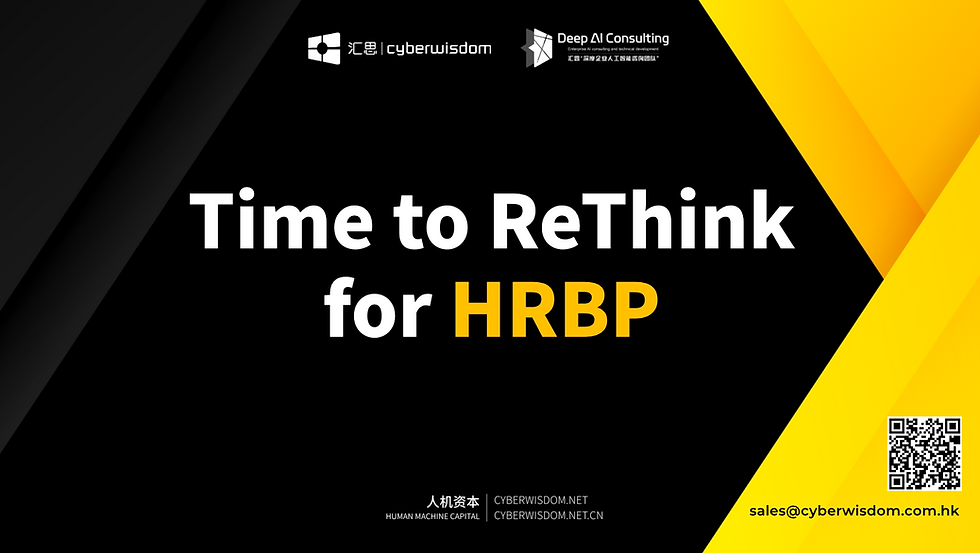
9. Conclusion
Merely grafting AI onto administrative HR workflows is a strategic cul-de-sac; the frontier advantage materializes when organizations convert discrete automation into coherent Human–Machine Collaboration ecosystems. The HRBP stands at the volatile intersection of business intent, human aspiration, algorithmic possibility, and ethical constraint. This makes the role more challenging—but also more consequential—than at any prior juncture.
To succeed, HRBPs must embrace an identity shift: from custodians of human processes to architects of adaptive, ethical, high-fidelity value networks. Mastery of orchestration design, trust governance, and data-informed narrative framing becomes non-negotiable. Enterprises that underinvest in this HRBP metamorphosis risk fragmented automation, talent disengagement, ethical missteps, and strategic stagnation. Those that elevate the HRBP into an HMC Orchestrator will unlock compounding collaborative returns: accelerated innovation loops, liberated human judgment bandwidth, resilient knowledge ecosystems, and differentiated market velocity.
In the HMC epoch, the HRBP is not simply “future ready”—they are the engine forging that future in real time.
About Cyberwisdom Group
Cyberwisdom Group is a global leader in Enterprise Artificial Intelligence, Digital Learning Solutions, and Continuing Professional Development (CPD) management, supported by a team of over 300 professionals worldwide. Our integrated ecosystem of platforms, content, technologies, and methodologies delivers cutting-edge solutions, including:
wizBank: An award-winning Learning Management System (LMS)
LyndonAI: Enterprise Knowledge and AI-driven management platform
Bespoke e-Learning Courseware: Tailored digital learning experiences
Digital Workforce Solutions: Business process outsourcing and optimization
Origin Big Data: Enterprise Data engineering
Trusted by over 1,000 enterprise clients and CPD authorities globally, our solutions empower more than 10 million users with intelligent learning and knowledge management.
In 2022, Cyberwisdom expanded its capabilities with the establishment of Deep Enterprise AI Application Designand strategic investment in Origin Big Data Corporation, strengthening our data engineering and AI development expertise. Our AI consulting team helps organizations harness the power of analytics, automation, and artificial intelligence to unlock actionable insights, streamline processes, and redefine business workflows.
We partner with enterprises to demystify AI, assess risks and opportunities, and develop scalable strategies that integrate intelligent automation—transforming operations and driving innovation in the digital age.
Vision of Cyberwisdom
"Infinite Possibilities for Human-Machine Capital"
We are committed to advancing Corporate AI, Human & AI Development, enabling enterprises to thrive in an era of intelligent transformation.
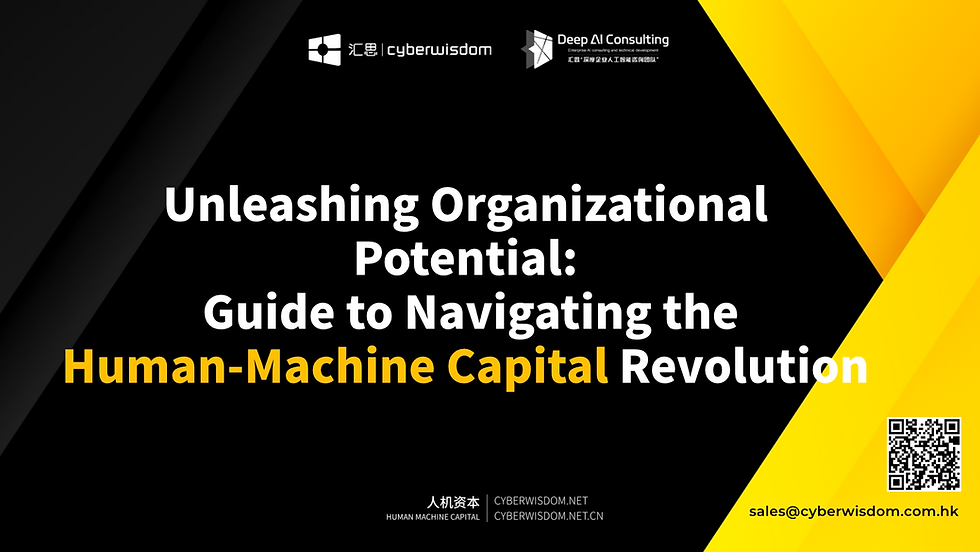
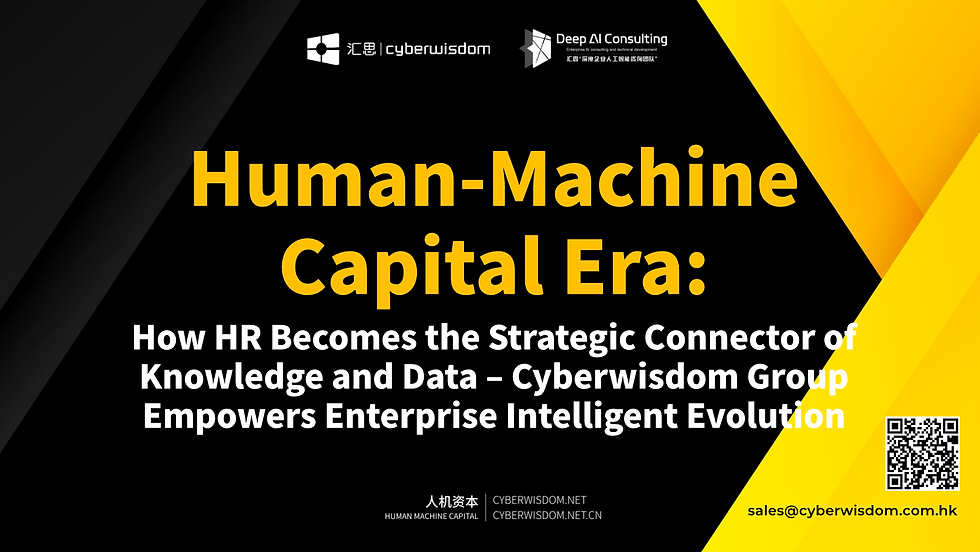
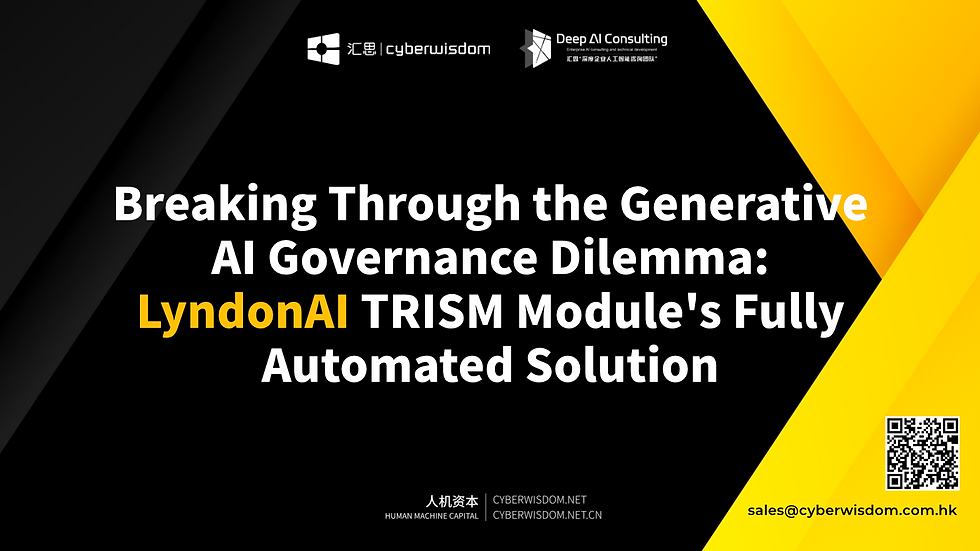
Comments